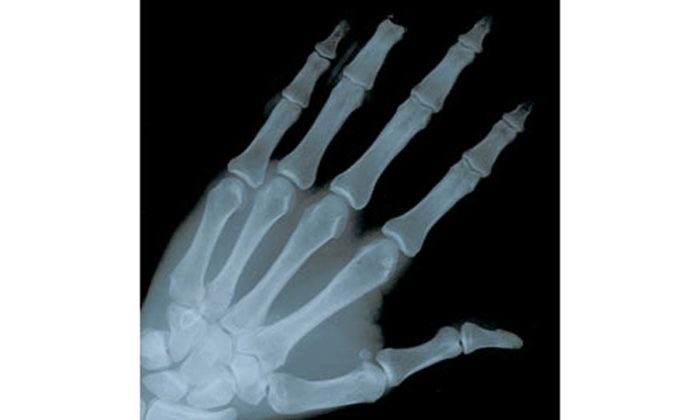Losing a Fingertip
A carpenter's journal entries reveal how the accident happened and how it changed his attitude about safety on the job site

Count the bones. Each finger should have four bones, but the ring finger has three, thanks to an encounter with the carbide-tipped blade on a saw.
On September 16, 1985, I sat on the examining table and watched a woman with a mop and a bucket on wheels clean up the blood that I had just trailed into the emergency room. She never looked up to see where the trail led.
I was waiting for the doctor. A nurse had already unwrapped the bloody shirt from around my hand, pulled off my wedding ring and surveyed the damage.
I cut off the tip of my ring finger on my left hand at the last knuckle. I also cut my thumb and little finger, but those would both heal 100%. My ring finger, however, would never be the same. The piece that I severed was ground up by the carbide-tipped blade on the table saw.
I felt stupid because of what I had done and embarrassed at being so stupid. I remember thinking it wasn’t worth it–being a carpenter. What was the point? A meager hourly wage, little or no respect, and risking this. I could have done as much with a car door, or an electric fan, or a dozen other household devices. But it wasn’t a car door; it was a table saw, one of the fundamental tools of my trade.
“The saw jerked the board out of my hands and threw it through the window behind me, 50 ft. into the street.”
I kept a journal at the time, recording my struggle to understand and accept what had happened. As injuries go, it wasn’t a big deal. One friend characterized it as “just a warning.” Once my hand healed, I could pretty much do everything I had done before. But the accident affected me far more psychologically than it did physically. I had to accept that I was not invulnerable, and as a consequence I began to take more seriously my responsibility for learning to use tools properly, and I also started to pay more attention to the little voice inside my head. In short, I became a safer carpenter. Recently I reread my journal entries concerning the accident, and I wondered if the entries might help others benefit from my experience. It is with that in mind that I present the following journal excerpts.
Sept. 19: How the accident happened — My priority the morning of the accident was to shim the cast-iron tub to the proper height for the marble tiles that were soon to be installed in the master bedroom. Ron and Scott were replacing a large set of casement windows in the library. I took all the measurements that I needed and headed downstairs to the table saw.
One of the shims had to be 3/8 in. thick. I set the saw at 3/8 in. between the blade and the fence and raised the blade height to half the width of my board, about 2 in. I was cutting a scrap of baseboard about 16 in. long, and I thought it would be wasteful to use the whole thing when all I needed was a 4-in. piece, so I just fed 6 in. into the saw, then withdrew it. Here is where I made the most serious mistake.
I should have shut off the saw and reset the fence so that I could turn the board over and be cutting at 3/8 in. on the far side of the blade. But I didn’t want to go to that trouble. I decided I could reach over the blade and plunge cut the last 6 in. of the board. It was about this time that Ron called to me from outside. I reached to shut off the saw, then decided to go ahead and finish what I was doing before seeing what he wanted.
As I was lowering the board into the saw, I got it twisted and bound. The saw jerked the board out of my hands and threw it through the window behind me, 50 ft. into the street. My left hand, which had been applying pressure against the board and toward the fence, went into the blade. I had to look at the hand to know what had happened. I don’t remember shutting off the saw, but I did at some point. Then I called to Ron and Scott, “Which of you is going to drive me to the hospital? I just cut my hand on the table saw.” I remember Ron thinking that I was kidding.
Sept. 21: A period of adjustment — I have now had six days to adjust to my accident and loss. The questioning of my career as a carpenter is pretty much over. The pain in my hand is no longer generalized but has reduced itself to a very specific soreness at the end of my finger.
Mental and physical strength, along with the wonderful narcotic effects of shock, carried me through the morning and afternoon of the accident. The worst physical aspect was not the accident itself, but later, at the doctor’s office, listening to the awful crunching sounds as the hand surgeon clipped away the shards of bone and rounded the end of the shortened fingertip.
The flashbacks were the most disturbing and the hardest to control. I kept looking down and seeing the ragged, bloody finger–an ugly hole where the tip had been. The vision shook me again and again. But time, merciful time, has robbed the scene of much of its dramatic effect. I can now call forth the image at will and look on it with equanimity.
At the doctor’s office today, it took a long time to get the bandages off my finger. I had to soak them in warm water and then slowly, painfully unwind them. After I finally got the bandages off, I sat on the examining table to stare at the hand, to begin getting used to it. Just then the nurse brought another woman down the hall to wait on the couch outside my door. It occurred to me that she might not be as anxious to study my bloody stump as I was, so I got up and closed the door.
Sept. 27: Going back to work — I was back at work on the job site this week. Wednesday and Thursday I put in full days. It was frustrating not to be able to do some things. I did, of course, bang my hand occasionally. I tired easily. But I believe that working has been good for me. It has lifted my spirits and taken my mind off things.
I was back on the table saw, too. It was hard. My fear at times was almost paralyzing. Part of the fear stems from the fact that I don’t have full use of my left hand and so cannot control the work as well. But the biggest part of the fear is just fear. Hearing the high-pitched whine of the motor and the rumble of the vibrating table makes my hand ache. And being back at work after the accident means facing the fact that it could happen again.
Sept. 28: Breaking the rules — I learned to use the table saw the same way that I’ve learned to use all of my tools: on the job site, through experience and observation–the latter more than the former. I was at the mercy of those around me and their knowledge and safety habits. There was no system of training, no regulation of the use of these tools. But this is no excuse. I should have taken it on myself to learn the rules.
As a result of the accident, I’ve been reading magazine articles and books, trying to learn about correct tool operation and safety. It was a confluence of mistakes, or rule violations, that caused my accident:
1. I was working with a short piece of wood, and although it was longer than the usual suggested minimum of 12 in., it was still too short to be safe.
2. I was resawing on the table saw, always a risky operation.
3. I was attempting a plunge cut, which is dangerous in many ways. I was doing this to save a 12-in. piece of wood for possible future use. How stupid can you get?
4. I wasn’t using any safety precautions–guards, push sticks, featherboards. Only the featherboard would have been usable in this operaton. It’s the one that would have saved my fingertip.
5. I was distracted. Ron called for me just before I made the cut. I reached to turn off the saw, then changed my mind, deciding to finish the job before seeing what he wanted.
6. I ignored the little voice in my head that was saying, “You probably shouldn’t be doing this; it’s dangerous.”
That’s a lot of things to be doing wrong at once, but the biggest mistake was that I didn’t even know all the rules I was breaking.
Oct. 10: Safety isn’t the prime concern — For most carpenters, myself included, safety is not a regular part of the mental process. Productivity is usually the prime concern. What is the fastest way I can get this job done? Sometimes quality is the prime concern. How can I achieve the best finished product? Whichever is the first, the other runs a strong second and tempers whatever decisions are made.
I don’t, as a regular consideration, ask myself, “What is the safest way of doing this job?” Only when my instincts wave a flag, and the little voice in my head shouts, “Hey, this is dangerous,” do I consider safety. And it is always relative.
There is danger inherent in all power tools, all cutting tools, hammers, pliers … danger of a serious fall every time I step above floor level onto a stool or a ladder or a scaffold. None of the work is ever 100% safe. I’m always arguing with the voice in my head, weighing the risk, factoring and compromising.
Instead of going downstairs to get a ladder, I stand on an upturned bucket because it’s easier and quicker. The little voice says it’s dangerous, but I think I’ll be all right. Most of the time I get away with it. On those rare occasions when I don’t, all that usually happens is that I slip off the bucket, land on my feet and say to myself, “Yes, I guess I better go get the ladder.”
But there is the chance that I could fall off that upturned bucket and break my leg, or hit my head, or lots of horrible things. Then I’d ask myself, “Why was I so stupid? Was I really trying to be productive, or was I just being lazy?”
Unfortunately, the other carpenters around me can have unhealthy effects on my willingness to listen to my own instincts. They can make me feel cowardly.
I’ll never forget the morning I got down off the roof because the shingles were slippery with dew. I told Bob I didn’t think it was safe up there and that I’d work at something else until the sun reached that side of the house. A few minutes later Bob was up on the roof nailing shingles where I had just been. It made him seem courageous and smart, when actually he was probably being stupid.
Oct. 21: Small loss, big change — Six weeks with the hand today. It looks good, isn’t too sore. The finger and the hand are still swollen most of the time. I can’t make a real tight fist. A Band-Aid and a piece of tape will be all I’ll wear on the finger today. I see the doctor on Wednesday. After that it’ll be six to eight weeks before I see him again.
At work I am unaware of it except when I have to use the table saw. Part of me is worried that already I’ve become complacent. But another part believes that the body has just taken over to get me back to work, productive, feeling good about myself as part of the emotional healing. My mind is then free to move, however slowly, toward assimilating all that has happened.
I actually lost very little–a finger tip–and yet the effects of this loss are far-reaching. Perhaps because it is so easy from this vantage point to extrapolate, to imagine losing a whole finger, a hand or even an arm. All of this from the loss of something smaller than a cigar butt.
If you are ever going to go back to work after an accident like mine, there are two things that you must do. First, settle in your mind how and why the accident happened. And second, while accepting that it could happen again, you must do what you can to ensure that it won’t.

























